Floral Motifs on Early Chintz
Erica sp. - Heath

%20H_web.jpg)
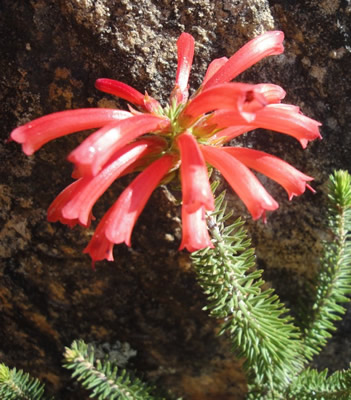
Erica abietina (Heath) growing in the wild.
Erica sp. (Heath) from Private Collection, Light Green and Brown print chintz fragment, date uncertain.
Erica abietina (Heath) illustrated as Erica exsurgens in H.C. Andrews, Coloured Engravings of Heaths, vol. 1: t. 22 (1794-1802).
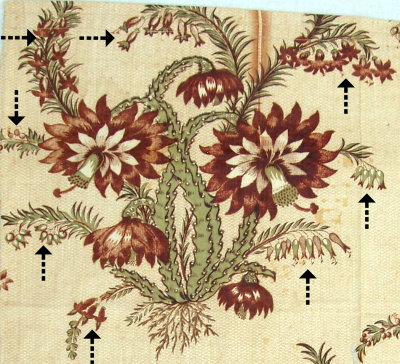
There are multiple heath branches indicated by arrows on the picture to the left. They are interspersed in a bouquet with a cactus plant in this motif. The also come in a variety of colorways including light green and brown, dark green and brown, tan, tan and indigo, and multicolored with orange-red flowers.
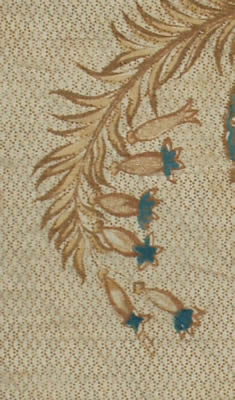

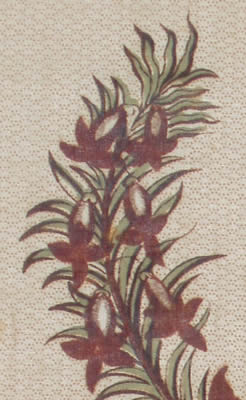


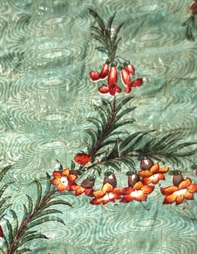
Common Names: Heath, heather, winter heather, spring heather
Description: Erica sp. (heath) is a genus of about 860 species within the Ericaceae (Heath) family. Various species of Erica are native Africa, Madagascar, the Mediterranean, and Europe including Great Britain. The botanical illustration and living plant photo above illustrate a species similar to the one shown on the circa 1830-1840 chintz. The Hortus Kewensis, ed. 2, vol. 2, pp. 360-409 recorded 186 species that were either native to Europe or introduced to Britain by 1811, most were from the Cape of Good Hope. There were two almost identical motifs on early chintzes illustrating Erica sp. (Heath) and Disocactus flagelliformis (Rattail cactus) in an entwined bouquet motif - an originally partially block printed motif and a contemporaneous cylinder printed copy. For a detailed discussion of both motifs and the variety of colorways and backgrounds known, see the Disocactus flagelliformis (Rattail cactus) page.
Quilts with the Erica sp. (Heath) and Disocactus flagelliformis (Rattail cactus) motif:
Chintz with the Erica sp. (Heath) and Disocactus flagelliformis (Rattail cactus) motif :
© Updated 7/8/2018 Author: Terry Terrell
Description: Erica sp. (heath) is a genus of about 860 species within the Ericaceae (Heath) family. Various species of Erica are native Africa, Madagascar, the Mediterranean, and Europe including Great Britain. The botanical illustration and living plant photo above illustrate a species similar to the one shown on the circa 1830-1840 chintz. The Hortus Kewensis, ed. 2, vol. 2, pp. 360-409 recorded 186 species that were either native to Europe or introduced to Britain by 1811, most were from the Cape of Good Hope. There were two almost identical motifs on early chintzes illustrating Erica sp. (Heath) and Disocactus flagelliformis (Rattail cactus) in an entwined bouquet motif - an originally partially block printed motif and a contemporaneous cylinder printed copy. For a detailed discussion of both motifs and the variety of colorways and backgrounds known, see the Disocactus flagelliformis (Rattail cactus) page.
Quilts with the Erica sp. (Heath) and Disocactus flagelliformis (Rattail cactus) motif:
- The Henry Francis du Pont Winterthur Museum, Sophia Myers Pearce Quilt, circa 1830-1840, Object Number1996.0011
- Philadelphia Museum of Art, Sarah Flickwir Quilt, dated 1841-1846
- Maryland Historical Society, Mrs. Elizabeth Clark Appliqué Quilt, The Baltimore Album Quilt Tradition, pp. 58-59, circa 1840
- International Quilt Study Center and Museum, Bars and Flying Geese Chintz Quilt, circa 1830-1850
- Charleston Museum – Chintz Appliqué Quilt Block, collection dated 1853-1855
- Roderick Kiracofe's The American Quilt , p. 79, quilt in the collection of Stella Rubin, circa 1825-1850
- Quilt sold by Crocker Farm Auctions in c. 2012
- Dunton's Old Quilts, Appliqué quilt Made by Miss Scott (Plate 68) “probably 1810”
- Dunton's Old Quilts, Appliqué (Tree of Life) coverlet owned by Mr. and Mrs. John M. Glenn (Plate70) not dated
- Dunton's Old Quilts, Appliqué coverlet owned by Mrs. Adams- Coffyn (Plate78) not dated
- International Quilt Study Center, Larison Family Quilt, dated 1841
- The Henry Francis du Pont Winterthur Museum, Indigo Resist Panel Quilt with Cactus Print Border, circa 1825-1850
- Fourth Corner Fine Quilt Gallery (sold), Wholecloth 4-Poster Bed Quilt, date uncertain
- Private Collection, Touching Stars Quilt Fragment, date uncertain but probably circa 1830-1840
- DAR Museum, Framed Center Medallion Counterpane, Object Number 3788, circa 1840-1850
- Private Collection, Triple Irish Chain Quilt with Red Cactus flowers, not dated
- Private Collection, Pieced Stars Quilt with Brown and White Cactus flowers, not dated
- Dunton's Old Quilts, due to wear, it is unclear whether the quilt top made for Rev. Thomas Wheeler in Charles Town, VA (now WV)(Plate7), 1847, is the block or the cylinder printed version of Disocactus
Chintz with the Erica sp. (Heath) and Disocactus flagelliformis (Rattail cactus) motif :
- The Henry Francis du Pont Winterthur Museum, Dark Green and Brown Print (1969.3124), circa 1830-1870
- Private Collection, Light Green and Brown Print, date uncertain
- Private Collection, Light Green and Brown Print, date uncertain
© Updated 7/8/2018 Author: Terry Terrell